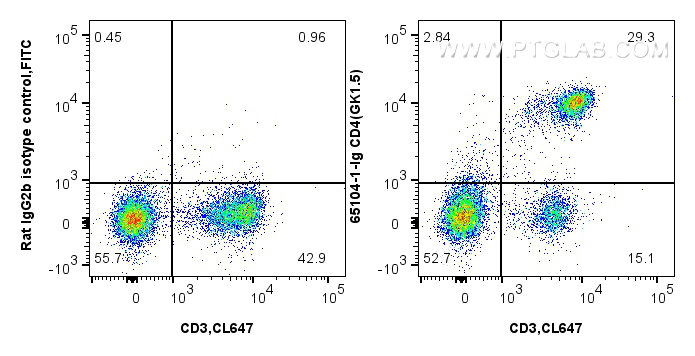验证数据展示
经过测试的应用
| Positive FC detected in | C57BL/6 mouse splenocytes |
推荐稀释比
| 应用 | 推荐稀释比 |
|---|---|
| Flow Cytometry (FC) | FC : 0.5 ug per 10^6 cells in 100 μl suspension |
| This reagent has been tested for flow cytometric analysis. It is recommended that this reagent should be titrated in each testing system to obtain optimal results. | |
| Sample-dependent, Check data in validation data gallery. | |
发表文章中的应用
| IF | See 1 publications below |
| FC | See 1 publications below |
产品信息
65104-1-Ig targets CD4 in IF, FC applications and shows reactivity with mouse samples.
| 经测试应用 | FC Application Description |
| 文献引用应用 | IF, FC |
| 经测试反应性 | mouse |
| 文献引用反应性 | mouse |
| 免疫原 |
Mouse CTL clone V4 种属同源性预测 |
| 宿主/亚型 | Rat / IgG2b, kappa |
| 抗体类别 | Monoclonal |
| 产品类型 | Antibody |
| 全称 | CD4 antigen |
| 别名 | CD4 antigen, GK1.5, L3T4, Ly 4, T-cell differentiation antigen L3T4 |
| GenBank蛋白编号 | BC039137 |
| 基因名称 | Cd4 |
| Gene ID (NCBI) | 12504 |
| RRID | AB_2918403 |
| 偶联类型 | Unconjugated |
| 形式 | Liquid |
| 纯化方式 | Affinity purification |
| UNIPROT ID | P06332 |
| 储存缓冲液 | PBS with 0.09% sodium azide, pH 7.3. |
| 储存条件 | Store at 2-8°C. Stable for one year after shipment. |
背景介绍
CD4 is a 55-kDa transmembrane glycoprotein expressed on T helper cells, majority of thymocytes, monocytes, macrophages, and dendritic cells (PMID: 9304802; 12213222). CD4 is an accessory protein for MHC class-II antigen/T-cell receptor interaction. It plays an important role in T helper cell development and activation (PMID: 9539765; 3112582). CD4 serves as a receptor for the human immunodeficiency virus (HIV) (PMID: 9304802).
实验方案
| Product Specific Protocols | |
|---|---|
| FC protocol for CD4 antibody 65104-1-Ig | Download protocol |
| Standard Protocols | |
|---|---|
| Click here to view our Standard Protocols |
发表文章
| Species | Application | Title |
|---|---|---|
Bioact Mater Photosynthetic microorganisms coupled photodynamic therapy for enhanced antitumor immune effect. | ||
J Tradit Complement Med Zhilong Huoxue Tongyu capsule alleviates myocardial fibrosis by improving endothelial cell dysfunction |


